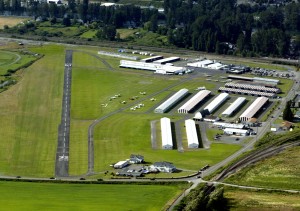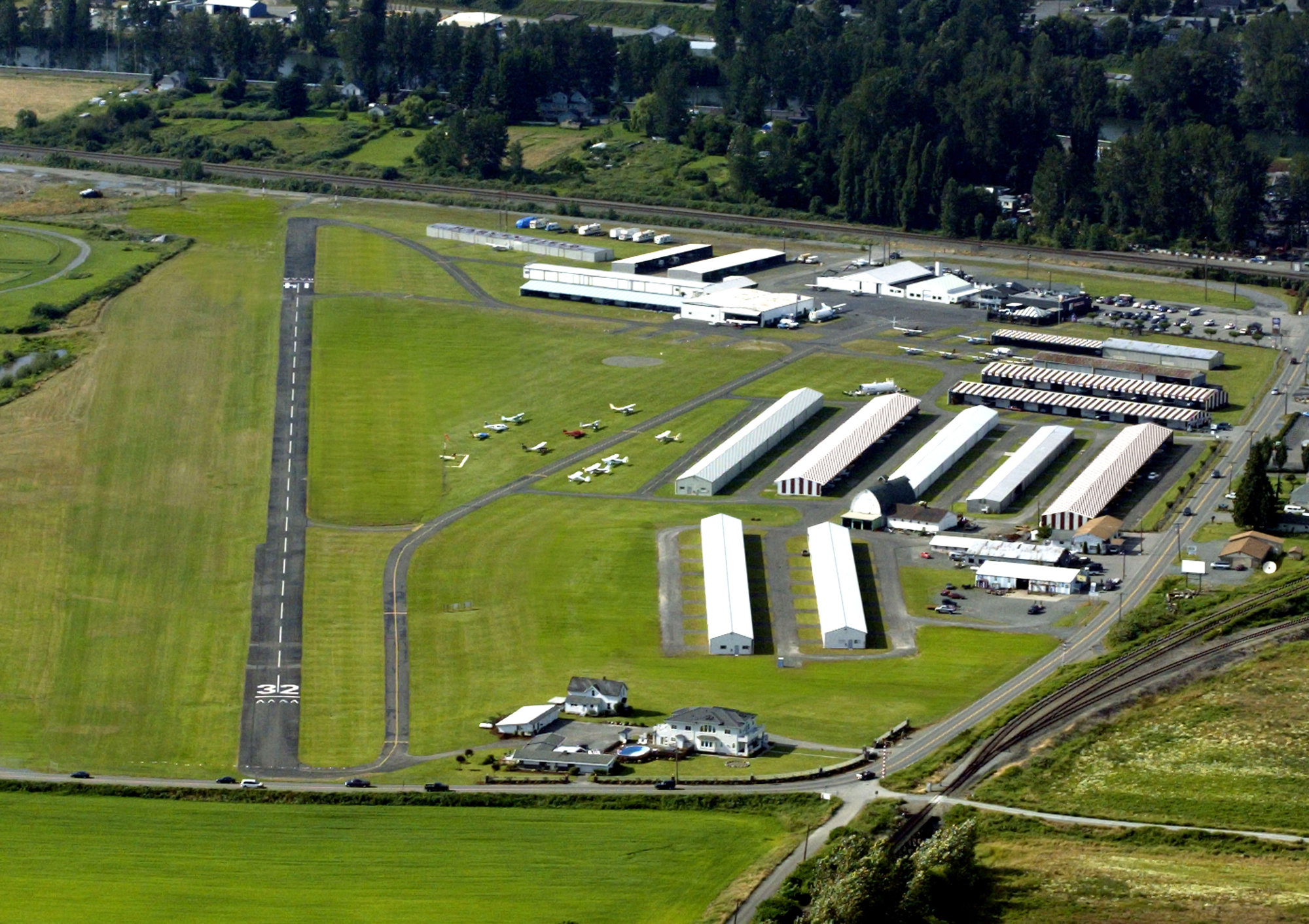By Terry Stephens

Citizens in Snohomish, Wash., are protesting the 20-year master plan being developed for Harvey Field. It would include moving the runway 300 feet south to resolve noise issues and the addition of new hangars to the west.
A proposed expansion of Harvey Field (S43) in Snohomish, Wash., one of the state’s most active general aviation airports, is drawing opposition from area residents. They fear it will bring excessive business development to the area and potential flooding from the adjacent Snohomish River.
But Kandace Harvey, who heads the family-owned aviation facility, said her plans would benefit the community by increasing business opportunities, reducing aircraft noise over the city and improving current airport operations, all without increasing the flood risk.
Harvey Field is currently base for 330 aircraft and has 140,700 flight operations annually. Harvey’s 20-year master plan proposal anticipates 214,500 annual operations by 2025, with nearly 400 aircraft based at the field. Harvey, the airport manager, wants to pave the existing grass airstrip, and clear the approaches to provide a 2,400-foot-long, 60-foot-wide runway, using the current paved runway as a parallel taxiway.
She also proposes building more hangars, a larger flight school facility, a new terminal building, a corporate hangar complex, a heliport, a new aircraft maintenance facility and additional aircraft parking on the empty grass fields to the west of the airfield.
The Harvey family’s 320-acre homestead, established in 1859, has ample space for expansion.
“Our family members live either on the airport’s 76 acres or on adjacent homestead land,” she said. “My kids—Lance, Heather, Tyson and Preston—are the fifth generation, and my grandchildren—Bailey, Paige, Lilly, Lukas and Sam—are sixth-generation Harveys. It’s my hope that many more generations of the family will continue to live, raise their families, work and pursue their dreams on the homestead land.”
Her hope may depend on whether she’s able to solve a problem that challenges many small general aviation airports across the country: public opposition to expansion, noise and flight operations in general.
“I face three major challenges: land-use and zoning issues as the area grows around us, operating an airport and industrial park in a flood plain, and aircraft noise,” Harvey said. “We don’t have a lot of difficulty with the sparsely settled rural residential area around us. But, at the north end of our runway, the city of Snohomish is just past the Snohomish River. We do get noise complaints from residents in four blocks of homes near the river.
“If our master plan is approved and zoning issues are resolved, we’d make a modest southerly shift in the runway and propose a road loop around the existing runway endpoints, to clear the approaches. These minor safety improvements would allow for an unobstructed 2,400 feet of useable runway surface and would place takeoff or landing aircraft at higher altitudes over the populated residential areas of the city. People in town would hardly notice the noise anymore.”
In the fall of 2005, Harvey fended off an effort to redesignate the airfield’s adjacent properties from airport industrial to riverway commercial farmland. Such a redesignation would have affected more than half of the airport’s land, prohibiting any future expansion. Local and transient pilots, as well as the Washington Pilots Association, Experimental Aircraft Association and the Aircraft Owners and Pilots Association assisted her in her efforts. The AOPA also stepped up to help Harvey oppose a rezoning effort in 1999.
Today, public discussion of the airport’s nearly-completed master plan has generated growing opposition. Some 90 area residents and farmers, who are opposed to the proposed changes, have formed Stewards of the Land & Community. They fear growth would lower their property values, create safety concerns and increase noise and flood risk around the airport.
The airport is in the city’s urban growth area, but the land is in Snohomish County, which is considering changing the current construction regulations to allow Harvey Field’s expansion. The Federal Emergency Management Agency’s approval of the county’s proposed changes would allow for new hangars and other buildings.
Then, other property owners in the area could also build new structures. That scares some local residents who are concerned about landfill and additional flood threats, since the Snohomish River periodically overflows its levees during heavy rain storms. However, during one of those typical flooding periods in November, floodwaters didn’t reach the airport or shut down operations, although some adjacent roads were under water and hampered access to the airport.
“The levies worked as they were designed, with recent changes after the 1990 flooding, so we had no problems,” Harvey said.
She’d like to meet with opponents to discuss their concerns. They haven’t accepted her offer.
“I feel we have a lack of communication. I don’t know where they’re getting their information,” Harvey said. “For generations, we’ve made airport development and expansion decisions based on life in the flood plain and its associated restrictions.”
Working in favor of Harvey’s proposal is the designation of the airport as an essential public facility, under the state’s Growth Management Act, a category that local jurisdictions are mandated to approve for operations and expansion needs.
FEMA recently remapped the Snohomish River Valley Flood Plain. When the remapping took place, the urban growth area was mapped “density fringe.” Previously, this area was mapped “floodway fringe,” allowing development for the airport and other commercial industrial landowners in the urban growth area.
Snohomish County is now completing hydraulic analysis and environmental work required to propose changes to FEMA for a flood map revision. That could return the urban growth area to the previous floodway fringe designation, including the remaining 56 acres in the urban growth area designated for airport industry and urban horticulture.
Because these two separate issues, the Harvey Field Master Plan and the Urban Growth Area Flood Map Revisions, are being processed at the same time, many people are confused, believing the two processes are one and the same.
“Also, many folks are under the impression that the master plan is complete, and we’re moving forward to construct a 3,500-foot runway,” she said. “While it’s true a 3,500-foot runway was considered, the final draft will propose a 2,400-foot runway with clear approaches, making it the smallest runway the FAA will recognize for approved airports.
To accommodate clear approaches, the existing runway must be moved 200 to 300 feet south, which would allow for the safety overruns and looping the road around the end of the runway.
All the proposed runway improvements would be subject to environmental and hydraulic studies, as well as flood plain restrictions, before they can be approved.
“The airport already owns the acreage required to accommodate the improvements,” Harvey said. “The county and state are already planning improvements to the road as a separate project. We wanted to weigh in with our plans at this time, in order to coordinate our efforts.”
Some residents think the airport is trying to double its hangar size. Harvey explained that road improvements would eliminate some existing hangars, so new ones would need to be built on the west side, along with other new facilities, to accommodate forecast growth. Helicopter operations will be moved to the undeveloped west side of the airport, to allow airspace separation from the airport’s general aviation aircraft and skydiving operations.
“In the end, when the final master plan is completed, the facts will prove our intent,” Harvey said. “It’s unfortunate that misinformation is causing many citizens to fear that the plan is complete, and that the airport is already moving forward to construct a 3,500-foot runway to accommodate jets. The runway improvements proposed would enhance safety for all and benefit local residents, the airport and pilot community as a whole. We would be better able to serve the region’s aviation needs and continue to provide jobs and industry, which contribute to the economic well-being of our community.”
A 2001 study by the Washington State Department of Transportation’s aviation division credited Harvey Field for providing nearly 450 jobs, more than $7.5 million in annual payrolls and an annual economic impact on the local community of more than $22.2 million.











